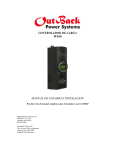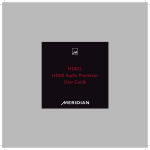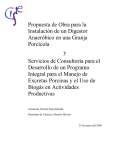Download Akiyama AMD-400 User manual
Transcript
TWIN CHANNEL POWER AMPLIFIER ETAPA DE POTENCIA DOS CANALES USER MANUAL MANUAL DE USUARIO AMD-240 AMD-400 FEATURES / CARACTERÍSTICAS ENGLISH ESPAÑOL ESPAÑOL ► Tres posibles modos de operacion: estéreo, paralelo y bridged mono. Permiten una aplicación flexible de la etapa de potencia. ► Una unidad de RACK ► Control independiente de nivel de salida para cada canal. Nos permite un ajuste óptimo del nivel. ► Sensibilidad de entrada seleccionable entre 0.775V, 1V, 1.4V. ► Funcionamiento a 4 & 8 Ohmios. ► Precisos testigos luminosos (LEDs) nos permiten ver en tiempo real el funcionamiento de la etapa y ajustar los niveles para evitar saturación. ► Sistema de refrigeración dotado de dos ventiladores sensibles a la temperatura para mantener en todo momento la temperatura óptima de trabajo del equipo. ► Conexiones de entrada; Canon (XLR) Balanceadas ► 4 (2x2) “Binding Posts” para conexión a cajas acústicas. ► Speakon® en cada canal para conexión a cajas acústicas. ► Transformador toroidal de alta corriente de gran fiabilidad y estabilidad. ► Protección contra corriente continua (DC) y Saturación (Overload) independientes en cada canal proporcionando protección a la etapa y los altavoces. ENGLISH ► Two-channel, parallel or bridged mono operating modes for flexible application. ► One RACK unit assembly. ► Independent limiters for each channel reduce distortion. ► Selectable Input Sensitivity between 0.775V, 1V, 1.4V. ► 4 & 8 Ohm operation load. ► Precise signal and clip led indicators to monitor performance, allow you to correct for overloading (clipping) condition. ► Two temperature controlled fans for better cooling. ► Balanced XLR input connectors. ► Four-way (2x2) output binding posts or speaker connectors enable secure operation. ► Speakon® Output for each channel. ► H i g h - c u r r e n t t o r o i d a l t r a n s f o r m e r f o r a b s o l u t e r e l i a b i l i t y. ► Independent DC and thermal overload protection on each channel automatically protects amplifier and speaker. WIRING/CONECTORES XLR Balanced Wiring Guide Speakon® Output Connector OUTPUT (Mixer) INPUT (Power Amplifier) 1= ground/shield 2= hot 1= (+ve) ground/shield 3= cold (-ve) 2= hot (+ve) 3= cold (-ve) for unbalanced use pin 1 and pin 3 to be bridged para uso no balanceado el pin 1 y el pin 3 deben ser puenteados 1 ENGLISH WARNING TO PREVENT FIRE OR SHOCK HAZARD. DO NOT USE THIS PLUG WITH AN EXTENSION CORD, RECEPTACLE OR OTHER OUTLET UNLESS THE BLADES CAN BE FULLY INSERTED TO PRESENT BLADE TO PREVENT FIRE OR SHOCK HAZARD. DO NOT EXPOSE THISAPPLIANCE TO RAIN OR MOISTURE. TO PRVENT ELECTRICAL SHOCK, MATCH WIDE BLADE PLUG TO WIDE SLOT FULLY INSERT. CAUTION RISK OF ELECTRIC SHOCK DO NOT OPEN CAUTION: To reduce the risk of electric shock, do not remove any cover. No user-serviceable parts inside. Refer servicing to qualified service personnel only. 1. Read Instructions All the safety and operating instructions should be read before this product is operated. 2. Retain Instructions. The safety and operating instructions should be retained for future reference. 3. Heed Warnings. All warnings on the appliance and in the operating instructions should be adhered to. The lightning flash with arrowhead symbol within the equilateral triangle is intended to alert the use to the presence of un-insulated “dangerous voltage” within The exclamation point within the equilateral triangle is intended to alert the user to the presence of important operation and maintenance (servicing) instructions in the literature accompanying this appliance. from both AC plug blades to all exposed metallic parts. The resistance should be more than 100,000 ohms. 14. Non-use Periods. The power cord of the appliance should be unplugged from the outlet when left unused for a long period of time. 15. Object and Liquid Entry. Care should be taken so that objects do not fall and liquids are not spilled into the enclosure through openings. 4. Follow Instructions. All operating and use instructions should be followed. 5. Water and Moisture. The appliance should not be used near water - for example, near a bathtub, washbowl, kitchen sink, laundry tub, in a wet basement, or near a swimming pool, and the like. 6. Carts and Stands . The appliance should be used only with a cart or stand that is recommended by the manufacturer. An appliance and cart combination should be moved with care. Quick stops, excessive force, and uneven surfaces may cause the appliance and cart combination to overturn. 16. Damage Requiring Service. The appliance should be serviced by qualified service personnel when: A: The power-supply cord or the plug has been damaged; or B: Objects have fallen, or liquid has been spilled into the appliance; or C: The appliance has been exposed to rain; or D:The appliance does not appear to operate normally or exhibits a marked change in performance; or E: The appliance has been dropped, or the enclosure damaged. 7. Wall or Ceiling Mounting. The product should be recommended by the manufacturer. mounted to a wall or ceiling only as 8. Heat. The appliance should be situated away from heat sources such as radiators, heat registers, stoves, or other appliances (including amplifiers) that produce heat. 9. Power Sources This product should be operated only from the type of power source indicated on the rating label. If you are not sure of the type of power supply to your home, consult your product dealer or local power company. For products intended to operate from battery power, or other sources, refer the operating instructions. 10. Grounding or Polarization This product may be equipped with a polarized alternation-current line plug (a plug having one blade wider than the other). This plug will fit into the power outlet only one way. This is a safety feature. If you are unable to insert the plug fully into the outlet, try reversing the plug. If the plug should still fail to fit, contact your electrician to replace your obsolete outlet. Do not defeat the safety purpose of the polarized plug. 11. Power-Cord Protection. Power-supply cords should be routed so that they are not likely to be walked on or pinched by items placed upon or against them, paying particular attention to the cord in correspondence of plugs, convenience receptacles, and the point where they exit from the appliance. 12. Cleaning - The appliance should be cleaned only as recommended by the manufacturer. Clean by wiping with a cloth slightly damp with water.Avoid getting water inside the appliance. 13. For AC line powered units - Before returning repaired unit to user, use an ohm-meter to measure 18. Ventilation Slots and openings in the cabinet are provided for ventilation and to ensure reliable operation of the product and to protect it from overheating, and these openings must not be blocked or covered. The openings should never be blocked by placing the product on a bed, sofa, rug, or other similar surface. This product should not be placed in a built-in installation such as a bookcase or rack unless proper ventilation is the manufacturer's instructions have been adhered to. ENGLISH 17. Servicing. The user should not attempt any service to the appliance beyond that described in the operating instructions.All other servicing should be referred to qualified service personnel. 19. Attachments do not use attachments not recommended by the product manufacturer as they may cause hazards. 20. Accessories Do not place this product on an unstable cart, stand, tripod, bracket, or table. The product may fall, causing serious injury to a child or adult, and serious damage to the product. Use only with a cart, stand, tripod, bracket, or table recommended by the manufacturer, or sold with the product. Any mounting of the product should follow the manufacturer's instructions, and should use a mounting accessory recommended by the manufacturer. 20. Lightning For added protection for this product during a lightning storm, or when it is left unattended and unused for long periods of time, unplug it from the wall outlet and disconnect the antenna or cable system. This will prevent damage to the product due to lightning and power-line surges. 22. Replacement Parts When replacement parts are required, be sure the service technician has used replacement parts specified by the manufacturer or have the same characteristics as the original part. Unauthorized substitutions may result in fire, electric shock, or other hazards. 23. Safety Check Upon completion of any service or repairs to this product, ask the service technician to perform safety checks to determine that the product is in proper operating condition. 2 given and if noise is given (saturation at mixer), it will be amplified. Naturally, that is bad. 15 min, Read me! Before unwrapping and starting your PowerAmplifier there are a few thinks you should know… Setting input levels at the mixer: Gain pot adjusts the input sensibility or so to speak the level of the input signal inside the mixer. It is paramount to set the right input level on every channel. Why is so important setting the correct input level? First, we have to understand the concept of Dynamic Range of an audio signal. The Dynamic Range of an audio signal is defined as the ratio between the maximum level before distortion and the minimum audible level. It is measured in decibels and gives us an idea of the amplitude of the signal. Dynamic Range Pic (Transient) Power amplifiers and loudspeakers: Current professional power amplifiers are quite reasonably protected against signal deterioration and excessive levels and shortcuts. Loudspeakers are not that well protected, hence a rule or some must be devised to use the correct speakers with a given power amplifier. Well, that rule is not a straightforward statement but more of an understanding of the principles and nature of the audio signal. The nature of the audio signal reefer to the type of music you are playing and more specifically of its Dynamic Range. The bigger the Dynamic Range the bigger the power amplifier needed. If the Dynamic Range of a give audio signal is big, the difference between the minimum level and maximum level of this audio signal will be big as well. Therefore, we will need an oversized power amplifier with enough power to amplify the maximum levels without reaching the saturation level at the power amplifier (normally, power amplifiers have red LEDs to let you know when they start saturating). As a vague rule we can say that Rock and highly compress music require a power amplifier delivering a power value slightly bigger than the rated maximum power of the speakers. However, we recommend the power amplifier rated power be 1.5 times bigger than the rated maximum power of the speakers. Example: if the power amplifier rated power is 200W RMS at 8Ω , the rated maximum power of the speakers should be 200x1/1,5=133,4W RMS at 8Ω. Using the power amplifier: Saturation and input levels. In order to make the most of your power amplifier you must watch two things: Dynamic range Ratio: Max. Level vs. Minimum audible level 3 Electroacoustic Signal 1- Set the volume controls in a way that the saturation LED lights up only occasionally (peaks). 2- Feed the power amplifier with an audio signal of the appropriate level. What is the appropriate level? Professional Power Amplifiers are set for an input level of 4 dBu. Do not panic, it is easy to get to it. 4 dBu is just a fixed measure of the audio signal that professional audio community uses as reference level, it can be expressed also in Volts 4dBu equals 1.23 Volt RMS. So to speak, the Power Amplifier will work at its best if feed with a signal of a level near the 4 dBu or 1.23 Volt RMS. How do we set this level? Easy, using the mixer appropriately. Incidentally, the nominal level for a professional audio mixer is also 4dBu. Therefore, if we set the master output level of the mixer carefully monitoring the output level meters (normally LED bars), we will ensure that the level of the audio signal fed to the Power Amplifier is near 4dBu because the nominal level of the mixer is 4dBu and we set correctly the output level or the mixer. 2 Minimum audible level 1 0 1 2 3 4 5 6 7 8 Time We have to acknowledge that a professional audio system is a serial bounded group of professional audio devices and that saturation or other signal deterioration present in one device will appear someway or another at the serial bounded following devices. If we deliver saturated signal from the mixer to the power amplifier we will not be able to get rid of this saturation whatsoever. The power amplifier will amplify all what is HEADROOM SATURATION ! Why we should avoid saturation? Obvious reasons aside there is a more “material” reason. Saturated signal can damage your speakers. Although some speakers have overload protection, a highly saturated signal can deliver D.C. and this phenomenon can easily shatter your speakers. SIGNAL DYNAMIC RANGE RATIO SIGNAL/NOISE We want the audio signal to fluctuate away from the maximum level (distortion begins) and away from the minimum level (or background level), where some noise is present due the nature of the ICs used in the electronic circuit (all ICs induce noise into the audio signal). At the draw, we depict this “safe” level within two discontinue lines. We have to set the level of input signal so that the signal peaks do not reach saturation levels and the lower amplitude parts of the signal are not too near the background noise level. ENGLISH Level or amplitude 4 NOISE 3 CONTROLS Front panel STEREO PARALLEL BRIDGE 4-8 OHM INPUT SENSITIVITY 0.775V 1V 1.4V TWO CHANNEL POWER AMPLIFIER 8 Rear panel BRIDGE (BRIDGE) BRIDGE CH-B CH-A CH-B SENSITIVITY CONNECT CH-B CH-A CH-A CONNECT CH-B AKIYAMA. 08191 BARCELONA (SPAIN) SPEAKON INPUTS OUTPUTS FRONT PANELCONTROLS REAR PANELCONTROLS 1 Power ON/OFF switch 2 CHA/CHB input level control When amplifier works in Bridged and Parallel mode, only CHAworks, CHB is disabled. 3 Power on indicator lamp ( Blue) When the amplifier works steadily, the led lights. 4 Signal level indicator (Yellow) The Led light when amplifier works in normal condition. The output power. Is higher, the light is stronger. 5 CHA, CHB peak value indicator lamps(Orange) The LED light when amplifier reaches is clipping level. Please adjust the input leveltill the cli LED flasheds, it mean that the amplifier works in normal condition. 6 CHA, CHB protect indicator lamps(Red) The LED will be light in the three situations: 1)When amplifier overload or short circuit. 2) When the power transistors temperature is over 90 degrees Celcius. 3) Something is wrong with the amplifier. 7 Air grill 8 Rack mount ears Two front panel mounting holes are provided on each mounting ear. 1 Power socket IEC connector forAC power cable. Connect the supplied heavy-gauge 3-pin IECpower cable. 2 Input voltage selector For Europe use 230. 3 CHA/CHB speaker output Loudpeakers connections. More info at page 8. 4 CHA/CHB binding post output Loudpeakers connections. More info at page 8. 5 CHA/CHB XLR input Connect the input source to these electronic balanced connectors. 6 Mode selection switch Selects operation mode. More info at page 10. 7 Sensitivity slection switch. Selects Power Amplifier Input Sensitivity. More info at page10. 8 Intelligent fan Two speed temperature sensible fans. ENGLISH CH-A 4 ATENCIÓN PARA EVITAR RIESGO DE ELECTROCUCIÓN ASEGÚRESE DE QUE EN CASO DE NO USAR UNA CONEXIÓN AC CON TOMA DE TIERRA LOS CONECTORES DE TOMA DE TIERRA DEL ENCHUFE DEL EQUIPO NO QUEDEN EXPUESTOS. CAUTION RISK OF ELECTRIC SHOCK DO NOT OPEN ATENCIÓN: para reducir el riesgo de electrocución, no manipule el interior del equipo. Para realizar el mantenimiento del equipo póngase en contacto con el personal cualificado Esta señal indica la presencia de lugares donde habiendo un elevado voltaje no presentan aislamiento y por tanto constituye un claro riesgo de electrocución. Esta señal indica la presencia de componentes del equipo que precisan de mantenimiento. Para más información sobre éstos lea el manual. 1. Lea detenidamente este manual antes de utilizar su equipo. distribuidor. 2. Mantenga el manual a su disposición para su uso en el futuro. 15. Daños en el quipo que precisen reparación. El equipo deberá ser reparado o revisado por personal cualificado en caso de: A. El cable de toma de corriente o su conector han sido dañados. B. Objetos o líquidos se han introducido en el equipo. C. El aparato ha sido expuesto a la lluvia. D. El equipo no parece funcionar o lo hace de modo poco usual. E. El aparato ha caído al suelo o presenta deterioros en su caja exterior. 3. Siga las advertencias que se le proporcionan en este manual. 4. Siga las instrucciones consignadas en este manual, un uso indebido podría dejar sin efecto la garantía. 5. Agua y humedad. No utilice el equipo cerca del agua o en lugares muy húmedos (fregadero, lavadora, etc.) para evitar riesgos de descarga eléctrica o fuego. 17. Ventilación. El aparato está provisto de hendiduras de ventilación, es importante no cubrirlas o bloquearlas. La ventilación del aparato podría verse comprometida resultando en un sobrecalentamiento que podría dañar el equipo. Tenga siempre en cuenta que colocar el aparato en un lugar sin ventilación puede producir un sobrecalentamiento de éste. ESPAÑOL 6.Transporte del equipo. Transporte el equipo con mucho cuidado. Los golpes o las vibraciones fuertes pueden dañarlo mecánicamente. 16. Mantenimiento. No abra el equipo para labores de mantenimiento pues en este aparato no hay piezas que necesiten manutención. En caso de que abriendo el equipo sea éste dañado o lo sea la persona que lo manipula la empresa no tomará ninguna responsabilidad por este servicio de mantenimiento no autorizado.Además en éste caso la garantía perdería su vigencia. 7. Montaje en pared o techo. Siga las instrucciones del fabricante. 8. Fuentes de calor. Tenga cuidado de no colocar el equipo cerca de fuentes de calor (Ej. Radiadores, estufas, amplificadores) 9. Voltaje. Antes de conectar el aparato a la red asegúrese de que se trata del mismo voltaje y frecuencia para las que el equipo está especificado. En caso contrario no conecte el equipo y póngase en contacto con su distribuidor. 10. Protección del cable. Escoja una posición para el cable de corriente de modo que esté lo menos expuesto a pisotones y demás agresiones. Especial atención con los dos extremos del cable de toma de corriente, la clavija de enchufe a la red y la clavija de alimentación del equipo. 11. Limpieza. Desconecte el equipo antes de realizar alguna operación de limpieza del aparato. Utilice un trapo suave y seco para limpiar. Asegúrese de que los cables están correctamente conectados antes de volver a enchufar el aparato. 12. Control de seguridad. La diferencia de potencial entre la toma de corriente de la pared y cualquier pieza metálica del equipo debe ser de al menos 100.000 ohmios. 18. Nunca utilice accesorios o modificaciones no autorizados por el fabricante. Ello puede afectar la seguridad del aparato y el fabricante no tendrá ninguna responsabilidad en este caso. 19. Accesorios. No deposite o instale el equipo sobre superficies o estructuras inestables. El aparato podría precipitarse y causar lesiones a las personas en las proximidades de éste. Cualquier montaje o instalación del equipo deberá ser realizado siguiendo las instrucciones o recomendaciones dadas en este manual o por el fabricante directamente. 20. Precaución durante tormentas. Durante una tormenta desconecte el equipo de la red para evitar que los posibles picos de corriente dañen el equipo. 21. Durante cualquier manipulación del equipo, para mantener todas las cualidades de éste tanto en prestaciones como en seguridad para el operante es necesario utilizar sólo recambios originales. Consecuentemente asegúrese de que la empresa que realice el mantenimiento esté autorizada por el fabricante o importador. 22. Comprobación de seguridad. Una vez realizada una reparación o servicio del equipo pida al personal cualificado que realice una comprobación para asegurarse de que el equipo le es devuelto en perfectas condiciones de uso. 13. Periodos largos de reposo del equipo. Desconecte el equipo de la red en caso de reposo prolongado. 14. Líquidos y objetos extraños. En caso de que algún fluido o pequeñas partículas sólidas sean derramadas sobre el aparato y se introduzcan en los circuitos apague el aparato y llévelo a su 5 capacidad de 200x1/1,5=133,4W RMS a 8Ω. 15 minutos, ¡Léame! Antes de comenzar a utilizar su etapa de potencia es muy importante que lea esta mínima introducción escrita con el propósito de ayudarle a obtener el máximo partido de su equipo. Para una óptima utilización del conjunto etapa-cajas el factor de sobredimensionado de la etapa deberá ser de 2. Es decir, una etapa de 200 W RMS a 8Ω por canal alimentará a dos cajas de 8Ω con capacidad para 100 W RMS cada una. Operación de la etapa de potencia: Saturación y niveles de entrada Protección de etapa de potencia y cajas acústicas Respecto de la protección contra daños a su etapa de potencia no hay mucho que decir porque ésta está diseñada de forma que sus distintos circuitos de protección la inmunizan de posibles deterioros. Pero sus cajas acústicas nos disponen de estas ventajas… ¿Qué cajas pongo? Aunque parezca mentira no existe una regla precisa al respecto. Y, es que en realidad no puede existir tal regla dado que todo dependerá del tipo de música que reproduzcamos. Más en concreto, dependerá de su dinámica. ¿Qué es la dinámica de una señal? A continuación veamos un gráfico Potencia vs. Tiempo de cómo se comporta la música o mejor dicho la señal electroacústica asociada a ésta. Para aprovechar al máximo la etapa deberemos ajustar los controles de nivel de entrada de modo que los LED de saturación “CLIP” solo se iluminen ocasionalmente. Las etapas AMD tienen un nivel de entrada nominal de 4 dBu (es un nivel de señal de 1,23 V RMS que corresponde al estándar de nivel de línea para uso profesional). Es decir, nuestra etapa trabajará en óptimas condiciones cuando la señal de salida de su mezclador hacia la etapa es de 4 dBu. La mayoría de mezcladores profesionales tienen un nivel nominal de 4 dBu, así pues, para que la señal entrante en la etapa sea la óptima simplemente asegúrese de no saturar la señal de salida del mezclador (utilice los LEDs de nivel del mezclador). Lo adecuado es que los LED rojos (saturación) sólo se enciendan ocasionalmente. Recuerde que si enviamos a la etapa señal saturada del mezclador, aunque atenuemos los controles de ganancia de entrada de la etapa la señal seguirá estando saturada. Y el resultado de la amplificación no será satisfactorio pues estamos amplificando una señal ya saturada. Rango Dinámico Pico (Transient) ¿Por qué debemos evitar la saturación? La señal saturada no sólo suena mal sino que puede destruir nuestras cajas acústicas. No vamos a extendernos en este tema, simplemente utilice los indicadores LED de la mesa de mezclas y etapa de potencia para evitar la saturación. 4 3 Señal electroacústica ESPAÑOL Nivel o amplitud Rango Dinámico Ratio Nivel máximo vs. Nivel mínimo audible 2 Nivel mínimo audible 1 0 1 2 3 4 5 6 7 8 Tiempo El rango dinámico es el ratio o cociente entre la señal más alta (sin llegar a distorsión) y la señal audible más baja. Se expresa en decibelios y nos da una idea de la amplitud de la señal. Una medida equivalente es el ratio S/N (Signal/Noise o Señal/Ruido). ! SEÑAL RANGO DINAMICO RATIO SEÑAL/RUIDO HEADROOM SATURACION Cuando mayor sea el rango dinámico más deberemos sobredimensionar la etapa de potencia. ¿Por qué? Al ser mayor el rango dinámico de la señal entrante (ésta presenta gran diferencia de niveles a lo largo del tiempo) la etapa puede llegar a saturación con facilidad, para evitar esta situación debemos disponer de más potencia para poder amplificar eficientemente la señal entrante sin que ésta sature la etapa (los LED “CLIP” de la etapa indican saturación). Por regla general podemos considerar que la música rock y la música altamente comprimida necesitarán unas cajas acústicas con una capacidad de potencia sólo algo inferior a la capacidad de la etapa de potencia, aunque nosotros recomendamos que se aplique un factor de 1.5. Es decir, si nuestra etapa proporciona 200W RMS a 8Ω, la caja acústica deberá tener una RUIDO 6 FUNCIONES Panel Frontal STEREO PARALLEL BRIDGE 4-8 OHM INPUT SENSITIVITY 0.775V 1V 1.4V TWO CHANNEL POWER AMPLIFIER 8 Panel Trasero BRIDGE (BRIDGE) BRIDGE CH-B CH-A CH-B SENSITIVITY CONNECT CH-B CH-A CH-A CONNECT CH-B AKIYAMA. 08191 BARCELONA (SPAIN) SPEAKON INPUTS OUTPUTS CONTROLES EN PANELFRONTAL Cada pieza dispone de dos agujeros para el montaje en Rack. 1 Conmutador ON/OFF 2 Control nivel CHA & CHB Cuando la etapa de potencia trabaja en modo “Bridge” o “Parallel” sólo funcionará CHA, CHB no está activo. 3 Indicador luminoso de encendido (Azul) Cuando la etapa de potencia está en marcha el LEDAzul se ilumina. 4 Indicador de nivel de señal (Amarillo) El LED se ilumina cuando la etapa de potencia trabaja a un nivel adecuado, a mayor potencia mayor intensidad luminosa del LED. 5 Indicador de saturación para CHA & CHB (Naranja) El LED se ilumina cuando la etapa de potencia satura, ajuste el nivel de entrada de modo que el LED sólo se encienda ocasionalmente (parpadea). 6 Indicador de protección para CHA & CHB (Rojo) El LED se ilumina en tres posible situaciones: 1) Cuando existe una sobrecarga o un cortocircuito. 2) Cuando los transistores de potencia alcanzan una temperatura superior a 90 grados. 3) Cuando aparece un problema indeterminado en el aparato del que éste se protege. 7 Reja de ventilación 8 Piezas para montaje en Rack CONTROLES EN PANELTRASERO ESPAÑOL CH-A 1 Conector a corriente AC Conector IEC (International Electrotechnical Commission) para el cable de conexión a red. Conecte el terminal de tres puntas IEC a este conector. 2 Selector de voltaje de alimentación Para Europa seleccione 230. 3 Conexiones a altavoces para CHA & CHB Vea el gráfico de la página 8. 4 Conexiones a altavoces para CHA & CHB mediante “Binding Posts” Vea el gráfico de la página 8. 5 Conexiones de entrada para CHA & CHB (Canon XLR) Conecte aquí las salidas de su mezclador. Vea el gráfico de la página 8. 6 Conmutador de selección de modo Ver más información en la página 10. 7 Conmutador de selección de sensibilidad Ver más información en la página 10. 8 Ventilación regulada por temperatura Se dispone de dos ventiladores con un circuito de control en función de la temperatura de los transistores de potencia. 7 CONNECTIONS / CONEXIONES Bridge (Mono) Jack 6.3 TRS Balanced mono/bridge A Binding Post A CH-A RCA CANON XLR3 Non Balanced CH-B BRIDGE BRIDGE CH-A (BRIDGE) BRIDGE CH-B BRIDGE CH-A Speakon CH-B mono/bridge SENSITIVITY CONNECT CH-A CH-B CH-A CONNECT CH-A INPUTS A CH-B B speakon +a pin 1 + speakon - a pin 2 + A CH-A CH-B SPEAKON INPUTS OUTPUTS Parallel Stereo Speakon Binding Post Speakon Binding Post A B A CH-A B A CH-A speakon + to pin 1 + speakon - to pin 1 - CH-A CH-B CH-A CH-B CH-A speakon + to pin 1 + speakon - to pin 1 - CH-B CH-A BRIDGE BRIDGE BRIDGE CH-B CH-B INPUTS INPUTS INPUTS INPUTS speakon + to pin 1 + speakon - to pin 1 - speakon + to pin 1 + speakon - to pin 1 - B B A A A CH-A CH-A CH-B A B A CH-B ESPAÑOL BRIDGE ENGLISH A CH-B AKIYAMA. 08191 BARCELONA (SPAIN) speakon + a pin 1 + speakon - a pin 1 - CH-A CH-A CH-B CH-A speakon + to pin 1 + speakon - to pin 1 - CH-A BRIDGE CH-B BRIDGE speakon + a pin 2 + speakon - a pin 2 - B speakon + to pin 2 + speakon - to pin 2 - INPUTS B B INPUTS B 8 SPECIFICATIONS Model ESPECIFICACIONES Stereo power 8Ohm AMD240 AMD400 Stereo power 4Ohm 400W Bridged power 8 Ohm Frequency response THD Rated Power@8Ohm Attenuation 10dB Rated Power@8Ohm IMD Rated Power@8Ohm Damping factor Input sensitivity Crosstalk Protect function LED indicator Connector Cooling systems Rated Power@8Ohm Rated Power@8Ohm ESPAÑOL Signal to noise ENGLISH Slew rate Rated Power@8Ohm Rated Power@8Ohm Overheat protection / Short circuit protection / Overload protection / Soft start / Limiter Protección térmica / Protección cortocircuito / Protección sobrecarga / Arranque progresivo / Limitador Active, Signal, Protect ,clip Input:Female XLR( x 2) Output:Binding Post(x2) Speakon(x2) Two intelligent adjustable speed fan Ventiladores de refrigeración regulados por temperatura Voltage Dimension Net weight 9 OPERATION MODE / MODOS DE FUNCIONAMIENTO ENGLISH ESPAÑOL Stereo Mode Modo Estéreo “Stereo Mode” BRIDGE BRIDGE In stereo mode, both channels operate independently, with their input gain controls. Signal at channel 1’s input produces output at channel 1, while signal at channel 2’s input produces output at channel 2’s output. Recommended minimum nominal load impedance for stereo operation is 4 Ohms per channel. En modo estéreo cada canal opera independientemente del otro, cada uno dispone de su control de ganancia de entrada. La señal de entrada en el canal 1 produce la señal amplificada en la salida del canal A y lo mismo ocurre con el canal B. Recomendamos que la impedancia mínima en los terminales de salida sea no inferior a 4 Ohmios. Parallel Mode Modo Paralelo “Parallel Mode” When set to Parallel mode, a signal applied to channel A input will be amplified and appear at outputs for both channel A & B. With set to parallel. The parallel mode is wellsuited for applications in which driving two speakers with the same signal but with separate amplification. BRIDGE En modo Paralelo, la señal aplicada al canal 1 aparecerá amplificada en los terminales de salida del canal A y el canal B. El modo Paralelo es adecuado para amplificar dos cajas acústicas con la misma señal pero con amplificación separada. BRIDGE Modo Bridge “Bridged Mono Mode” Bridged Mono Mode BRIDGE Use extreme caution when operating the amplifier in Bridged Mono Mode. Never ground either side of the speaker cable when the amplifier is in Bridged Mono Mode ; the speaker load must “ float “ away from the amplifier chassis. BRIDGE Nota : El modo “Bridge” sólo debe ser utilizado con cajas de impedancia de 8 Ohmios. El uso de la etapa en modo Bridge con cajas acústicas de 4 Ohmios o menos puede resultar en un severo deterioro del equipo debido a la gran cantidad de corriente y temperatura generados que pueden deteriorar los circuitos de protección y provocar fallos en la unidad así como en las cajas acústicas. Es preciso tener cuidado cuando usamos el amplificador en modo Bridge, nunca debemos conectar a tierra ambos lados del cable de altavoces; la carga del altavoz debe “flotar” sin contactar con el chasis del amplificador. ESPAÑOL Note : Bridged mono mode is to be used only when the AMD Series is connected to 8 ohms speaker load. Use of Bridged mode with speaker loads of 4 ohms or less can result in severe damage to the unit due to excessive heat and current limiting. El modo “Bridge” aúna las potencias de los amplificadores de canal A y canal B en un solo amplificador monoaural de gran potencia. Un canal empuja “push” y el otro tira “pull” de igual modo. Doblando la potencia respecto de un canal sólo. De este modo el voltaje es doblado, la potencia máxima “Peak Power” es cuadruplicada y la potencia Programa- es aproximadamente triplicada respecto de la de un canal solo. La señal entrante se conecta únicamente a la entrada del canal A y únicamente el control de ganancia de entrada del canal A estará activo. El control de ganancia del canal B permanece inactivo. ENGLISH Bridged mono mode straps both amplifier channels together to make a very powerful, single-channel monaural amplifier. One channel ”pushes” and the other channel “pulls” equally, doubling the power over that of either channel alone. Therefore the voltage is doubled, the peak power is quadrupled, and program power is roughly three times as high as that of the individual channel. Signal is applied to the channel A input only and channel A input gain control is used to adjust signal level. The input gain control belonging to channel B are not used. SENSITIVITY SETTING / AJUSTE DE SENSIBILIDAD Power amplifier sensitivity: The input level required to produce one watt output into a specified load impedance, usually 4 or 8 ohms. [EIA-490] (definition) First, please know that "sensitivity" is not the same as power. It doesn't matter whether you chose the low or high sensitivity option, the amplifier will have the same power output. What will change is how loud you set the volume control (among other things). To set your input sensitivity, turn you amp's input sensitivity to minimum setting (0.775V). Now start with your unit at its lowest volume and turn it up until you hear distortion and then back off some. Some units will let you go to full volume without distorting the pre-amp level outputs. Now with your unit putting out its max clean voltage, turn the input sensitivity up (1.0V/1.4V) until you get to the loudest your system will play without distortion or the loudest you ever care to listen, whichever is lower. Now your amp is set to amplify the least amount necessary to produce full volume making it amplify noise the least. Note: the higher the Input Sensitivity (low sensitivity) the lower will be the noise amplified. Sensibilidad de entrada (Input Sensitivity): es la cantidad mínima de señal que debemos proporcionar al amplificador para que éste pueda amplificar dicha señal hasta su máxima capacidad de potencia. Llamamos Ganancia a la “cantidad” que un circuito electrónico amplifica una señal de entrada. No debemos confundir la sensibilidad de entrada con la potencia, en realidad, sea cual sea la sensibilidad de entrada que escojamos la potencia que el amplificador es capaz de proporcionar es la misma. Utilice la siguiente regla para determinar la sensibilidad adecuada para su equipo: seleccione el nivel de sensibilidad mayor (0.775V), desde cero vaya aumentado el volumen del amplificador hasta que comience a escuchar saturación. En este punto disminuya una poco el volumen hasta no escuchar saturación. Seleccione los dos restantes valores de sensibilidad de entrada hasta que el sistema (reproductor + amplificador + cajas acústicas) suene más alto sin distorsión o simplemente al volumen máximo al que usted quiere oír el equipo. De este modo su amplificador utilizará la mínima señal entrante necesaria para obtener el resultado requerido. Siendo la mínima señal de entrada significará la mínima amplificación de ruido. Nota: a mayor sensibilidad mayor es la amplificación del ruido. 10 C/ Praga, no11 . Pol. Ind. Cova Solera
This document in other languages
- español: Akiyama AMD-400


























